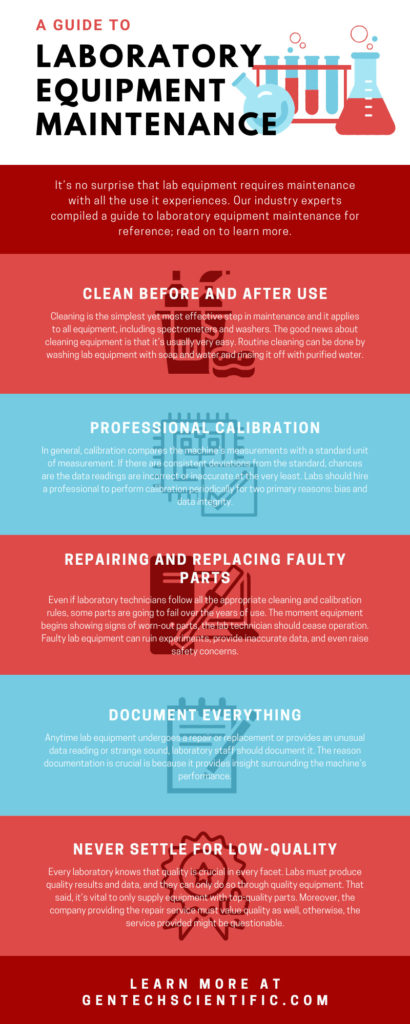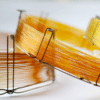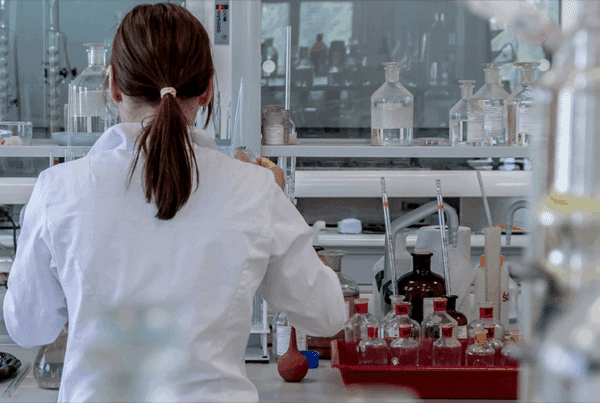The importance of regular maintenance for lab equipment cannot be stressed enough. Laboratories are the beating heart of scientific research and innovation. Within these controlled environments, scientists and lab technicians strive to make groundbreaking discoveries and advancements across various fields. However, the success of these endeavors heavily relies on the proper functioning of laboratory equipment. Regular maintenance of these instruments is not merely a best practice recommendation, but an essential requirement for achieving accurate and reliable results. Below we explore the reasons maintenance is so critical, as well as some best practices for implementation.
Ensuring Precision and Accuracy
Laboratory equipment is designed to operate with remarkable precision, as detection of minuscule changes or variations is often required. However, over time, wear and tear can compromise this precision. Regular maintenance routines, including calibration, alignment, and verification, help ensure that instruments continue to deliver accurate and repeatable results.
Calibration involves comparing the output of an instrument to a known standard, making adjustments as necessary to correct any discrepancies. This process is particularly crucial for analytical instruments such as spectrophotometers, chromatographs, and balances, where even minor deviations can lead to significant errors in results.
Preventing Breakdowns
When equipment is not properly maintained, it is more likely to break down. Downtime means lost productivity, and possibly lost revenue, customer dissatisfaction, compliance issues and even safety hazards.
Extending Instrument Lifespan
Laboratory equipment represents a significant investment, often requiring substantial financial resources. Regular maintenance helps protect this investment by extending the lifespan of the instruments. By addressing minor issues before they escalate, technicians can prevent major breakdowns that could lead to expensive repairs or replacements.
Simple tasks like cleaning filters, lubricating moving parts, and replacing worn-out components can go a long way in preventing premature deterioration. Moreover, preventive maintenance reduces the likelihood of unexpected downtime, which can disrupt research schedules and delay critical experiments.
Mitigating Safety Risks
Laboratory environments can harbor potential hazards, ranging from chemical exposures to biological agents. Malfunctioning equipment can lead to accidents, spills, or exposure incidents that endanger both laboratory personnel and the integrity of the research being conducted. Properly functioning equipment plays a pivotal role in minimizing these risks.
Routine maintenance includes safety checks, such as inspecting ventilation systems, gas lines, and electrical connections. This vigilance ensures that equipment operates within specified safety parameters, reducing the chances of incidents that could jeopardize the well-being of lab workers and the environment.
Preserving Data Integrity
In the era of data-driven research, maintaining the integrity of experimental data is paramount. Laboratory instruments are often interconnected with data acquisition systems and software. Inaccuracies in measurements due to equipment malfunction can lead to skewed results and flawed conclusions.
Regular maintenance helps safeguard data integrity by minimizing the potential for data errors. Technicians should not only focus on the hardware aspects of the instruments but also ensure that software systems are up to date and compatible with the hardware. This comprehensive approach guarantees that the data collected remains trustworthy and credible.
Best Practices for Regular Maintenance for Laboratory Equipment
Establishing effective maintenance routines requires a systematic approach:
- Create a Maintenance Schedule. Develop a schedule that outlines when each instrument should undergo maintenance. Consider factors like usage frequency, manufacturer recommendations, and historical performance.
- Document Everything. Maintain thorough records of maintenance activities, including dates, tasks performed, and any issues discovered. This documentation can assist in identifying patterns and making informed decisions about repairs or replacements.
- Train Technicians. Ensure that laboratory personnel are trained to perform basic maintenance tasks and recognize signs of equipment deterioration. This empowers them to take prompt action and report potential problems.
- Follow the Manufacturer’s Instructions for Use and Maintenance. Maintain a library or link tree of relevant manuals and/or video demonstrations of maintenance procedures for your instruments.
- Have a Backup Plan in Place in Case of Equipment Failure. This should include a plan for emergency repairs, contact information for qualified repair technicians, as well as a list of spare parts. Options for backup instrumentation, such as rental or lease options, can also be useful.
- Budget for Maintenance. Allocate resources in your budget for regular maintenance and unforeseen repairs. A well-maintained laboratory is an investment that pays dividends in the quality and reliability of research outcomes.
More Resources:
- 4 Maintenance Tips to Prevent Damaging Your Lab Equipment
- What Should Be Included in Lab Maintenance Checklist
- Benefits of Preventive Maintenance for Your Lab Equipment
- Visit GenTech Scientific’s YouTube Channel for more maintenance, repair and tech tips!
- Learn more about how GenTech can support your preventive maintenance needs








